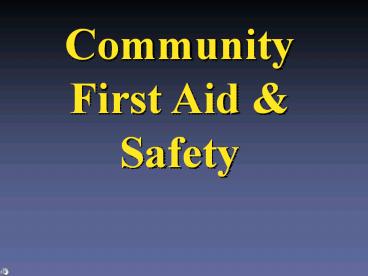CPR/First Aid - PowerPoint PPT Presentation
1 / 24
Title:
CPR/First Aid
Description:
Community First Aid & Safety Consider this: The most important step you can take in an emergency: Bystander s Part in the Chain of Survival Did you know . . . ? – PowerPoint PPT presentation
Number of Views:158
Avg rating:3.0/5.0
Title: CPR/First Aid
1
Community First Aid Safety
2
You arrive at the mall with your friend when
suddenly you hear commotion.
Oh, no! Someones collapsed!
Even though a crowd has gathered, no one is
helping.
Someone needs to help right now!
Are you equipped to help?
3
If not you
who?
4
Consider this
- Over 37 million injury-related visits were made
to U.S. hospitals in 2000.
- These injuries resulted in almost 90,000 deaths.
5
- Previously, infectious diseases caused the
greatest risk to the well-being of children . . .
But now, unintentional injuries cause most
childhood deaths.
6
- More than 60 million people in the U.S. have
heart disease.
- Cardiovascular disease causes about 1 million
deaths in the U.S. each year.
- That accounts for over 40 of all U.S. deaths
that occur annually!
7
- Over 600,000 Americans have strokes each year
more than 16,000 Americans die annually from
stroke.
EVERYONE should know what to do in an emergency.
8
Leading causes of Death ages 0 to 44
Accidents - 53,027
25
20
15
Heart Disease 22,327
Cancer - 24,675
Homicide 14,819
Suicide 16,661
10
5
9
The most important step you can take in an
emergency
Call 911!
The sooner emergency help arrives, the better a
persons chance of surviving.
10
Bystanders Part in the Chain of Survival
3. 1st responder Care (CPR/AED)
2. Call 911
1. Recognize emergency
4. EMT care
6. rehab
5. Hospital care
11
Did you know . . . ?
You are more likely to give care to a family
member or a friend than to someone you dont know.
12
Recognizing Emergencies
- Unusual noises screams, moans, breaking glass,
crashing metal changes in machinery noises.
- Unusual sights stalled vehicle, overturned pot,
spilled medicine container, broken glass, downed
electrical wires, smoke or fire.
13
- Unusual odors odors that are stronger than
usual, unrecognizable odors, burning odors
- Unusual appearances or behaviors trouble
breathing, clutching chest or throat, slurred or
confused speech, sweating for not apparent
reason, confusion, unusual skin color.
14
Reasons People Fail to Act In An Emergency
- Presence of other people uncertainty that an
emergency really exists. - Fear of the type of injury of illness.
- Fear of catching a disease.
- Fear of doing something wrong.
- Fear of being sued.
15
If there are several people around . . .
- It may be difficult to tell what the emergency is
if anyone is providing first aid. - Dont be embarrassed about coming forward in
front of others. Ask if you can help. - Things you can do call 911, keep area free of
onlookers traffic, give care.
16
When an injury or illness is frightening to be
around.
- Take a deep breath and try and remain calm.
- Remember you cannot effectively help someone if
you are panicking.
17
Could I catch a disease if I help?
- Always avoid contact with body fluids when
possible. - Try to use protective breathing barriers, gloves,
clean dry cloths. - Cover cuts sores.
- Wash hands after providing care.
18
Could I be sued for trying to help?
- Most states have enacted Good Samaritan laws.
- Reasonable prudent care is protected under the
law. - Always use common sense reasonable level of
skill.
19
Preparing For Emergencies
- Keep medical information about you your family
on refrigerator or other handy place. - Keep a first aid kit in home or car.
- Keep emergency telephone numbers by telephone or
in first aid kit. - Learn practice first aid skills.
20
Good things to keep in 1st aid kit
- antiseptic ointment
- gauze/gauze pads
- adhesive tape
- band-aids (assorted sizes)
- tweezers
21
- disposible gloves
- protective mouth barrier
- OTC Medications Benedral, tylenol, aspirin,
antacids
22
Dont forget . . .
23
Accidents Shatter Lives
24
Are you ready to learn how to take action?































